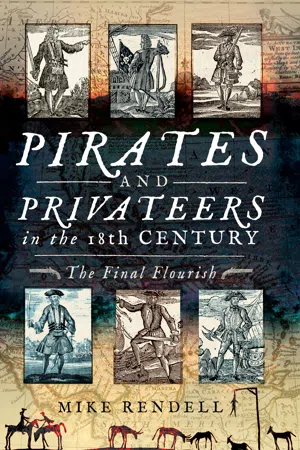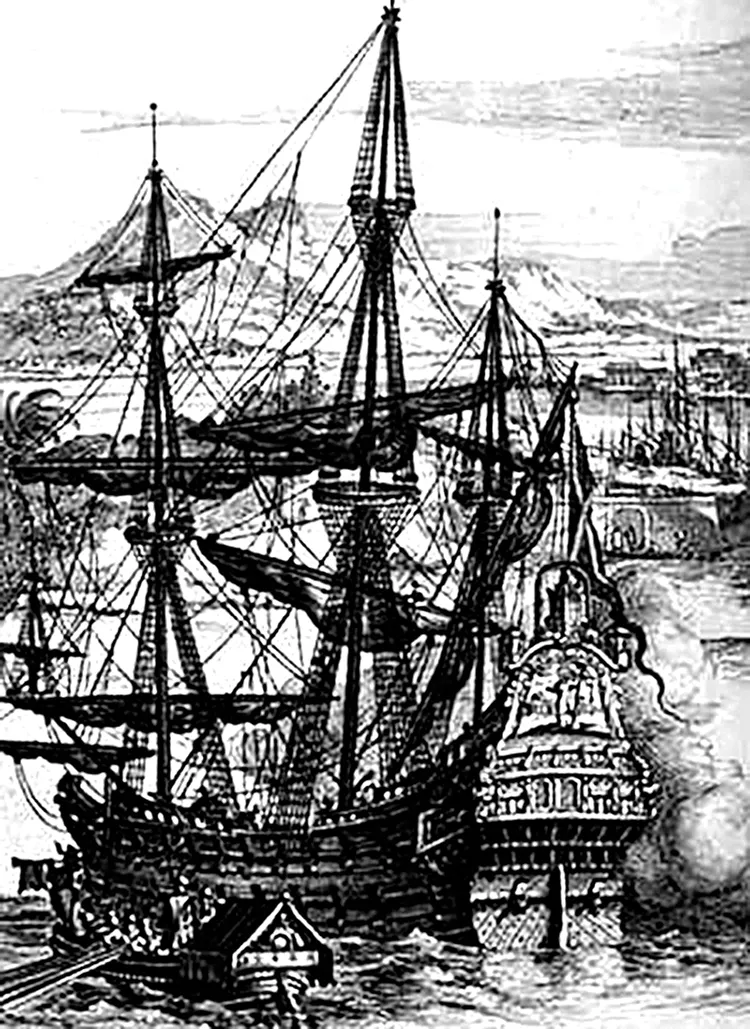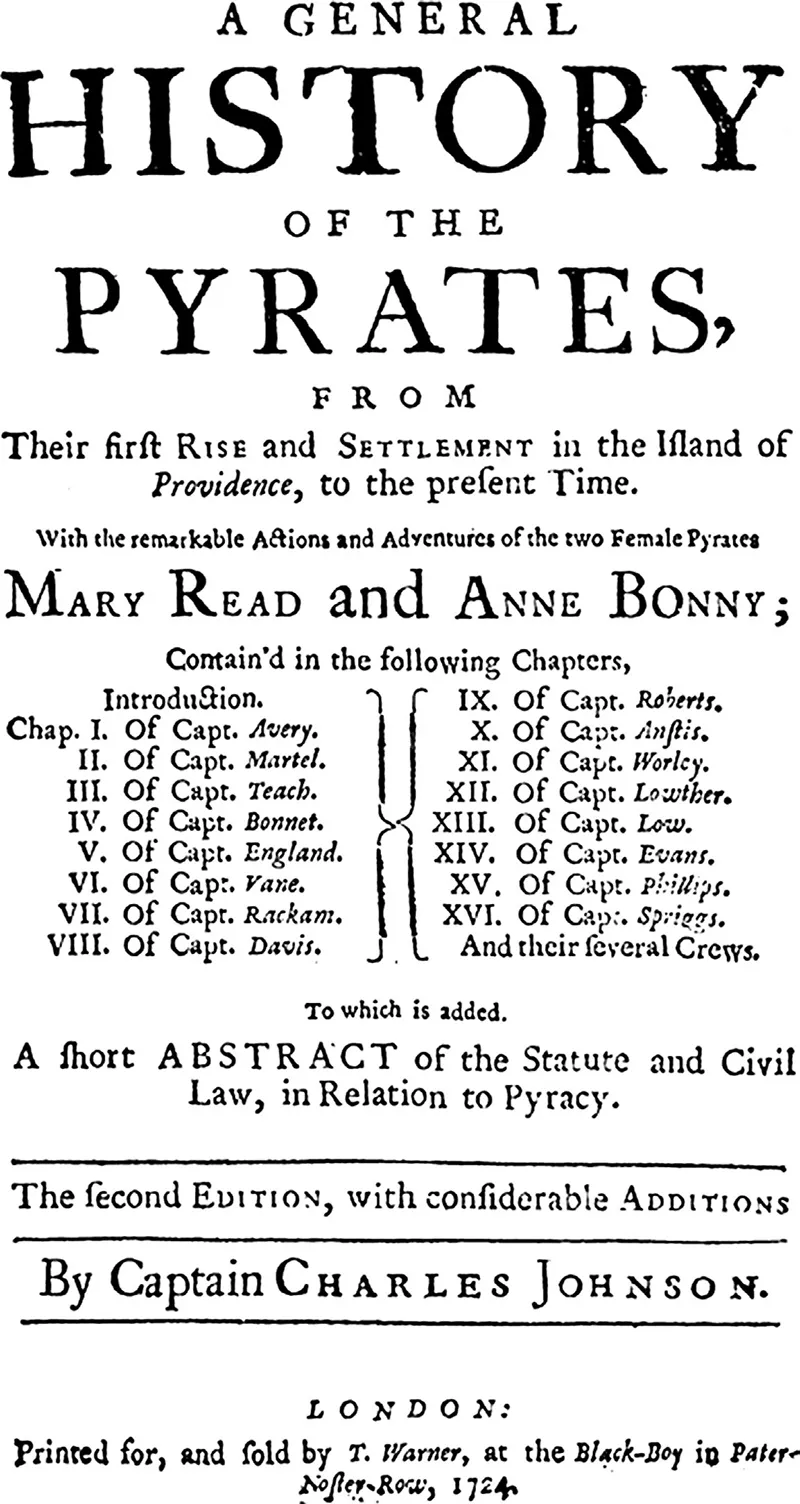![]()
Part One
BACKGROUND
A seventeenth century Spanish galleon.
![]()
Chapter 1
A General History of the Pyrates
This present book is about pirates and privateers, particularly during the final phase of their ‘golden age’. It is, however, important to distinguish between the two groups. Piracy was illegal. It was regarded as a threat to international trade; its practitioners were despised and reviled. Pirates were seen as the scum of the earth, a menace to society. Privateers on the other hand were patriotic sailors serving the interests of their country; hard-working and pursuing a noble cause. In practice, both groups did precisely the same thing – they went to sea in order to capture other vessels, to loot their cargoes and to grow rich on the proceeds of plunder. The only difference between the two groups was that privateering was legal – encouraged by a government which found it convenient to leave private individuals to implement foreign policy without involving the state in expense or responsibility. The distinction between pirate and privateer was that the latter held a Letter of Marque, but even this distinction was blurred, because many privateers exceeded their authority and stepped over into piracy. Other pirates became privateers – at least in their own minds – because they managed to purchase a Letter of Marque corruptly, or simply joined up with other privateers to form a mixed squadron of vessels lying in wait for their prey.
Admiral Horatio Nelson was one person who saw little distinction between the two classes of mariner, writing that ‘the conduct of all privateers is, as far as I have seen, so near piracy that I only wonder any civilized nation can allow them’.
Where the distinction between piracy and privateering is unclear, it is easier to use the term ‘buccaneer’ because it avoids making a distinction. The word comes from the Carib word ‘buccan’ meaning a wooden frame on which strips of meat would be air-dried. The meat was often eaten by sailors throughout the Caribbean – hence ‘buccaneers’. Strictly speaking it does not therefore apply to ‘the Brethren’ (as pirates sometimes called themselves) in other parts of the world.
It is difficult to escape the conclusion that if the person committing the piratical act was British, it was viewed in Britain in a wholly different light from an act by, say, a Frenchman or a Spaniard. Even more xenophobic, if the victims were Indian, or from one of the countries bordering the Arabian Gulf, then this was seen almost as a just dessert – they were too rich for their own good, and relieving them of their jewels and vast fortunes was in some way ‘fair’.
Pirates generated a fascinated horror in the eyes of the general public in the eighteenth century. This fascination was fed by one particular book, published in 1724 under the pseudonym of Captain Charles Johnson, and entitled A General History of the Robberies and Murders of the most notorious Pyrates. This book, more than any other, fed and inspired the public appetite for stories of piracy and mayhem on the High Seas.
For years it has been assumed that the book was actually the work of Daniel Defoe, who, it is believed, used several hundred aliases during his career. More recently the finger of authorship has been pointed at a Grub Street hack called Nathaniel Mist. Quite possibly one of the reasons why Defoe was assumed to be the author was that he was a ‘plant’ in Mist’s printing offices, put there by the Walpole administration to spy on Mist and to keep an eye on his activities.
Certainly, Mist would have had the contacts in the government – and the knowledge of seamanship - to have assembled this tale of over thirty pirates. In a way the authorship is neither here nor there – the book fitted in with a series of other stories designed to frighten and fascinate. Similar tales about notorious highway robbers, or about sensational murders, gripped the readership of what would later be termed ‘penny dreadfuls’. Safe in the security of their own homes, men and women could read about dastardly deeds and swashbuckling buccaneers – and be glad that they were not adrift on the Seven Seas, pursued by black-hearted villains and bearded cut-throats.
The General History was a commercial success – and it also became the inspiration for many subsequent authors including Robert Louis Stevenson with Treasure Island (1883) and J M Barrie with Peter Pan (1911). In its original form, the General History was issued in two volumes: the first, covering the most recent period of piracy, gave biographical details of twenty-one pirates; and the second dealt with the earlier exploits of another thirteen pirates, of whom perhaps three were fictitious. Their inclusion obviously casts doubt on the veracity of some of the other stories told about real-life pirates. The author was clearly not going to let the truth get in the way of a good story….
Within two years the book had run to four editions, and these established pirate literature as a sub-genre in its own right. Running to over 300 pages, the General History was of course a work of fiction – and many of the facts set out in it are uncorroborated and quite possibly heavily embellished. It does however introduce its readers to one-legged pirates with wooden crutches, and half-blind pirates with eye patches, and puts forward the idea of buried treasure. It painted its tales with gunnels awash with blood, and generally set the tone for the tongue-in-cheek portrayal of pirates in modern day films such as Pirates of the Caribbean. The book romanticised the stories, giving the characters a mythical status. The murders, the thieving and the torture became exciting tales of derring-do, designed to terrify, excite and amuse. They were not intended to be truthful – and may even have been inspired by the author’s Jacobite anti-establishment views. If the author was indeed Nathaniel Mist, he had once served as a sailor on board a ship operating in the West Indies. He knew the hardships faced by sailors, and had experienced their conditions, eaten their food, survived on their wages.
He later went on to publish his Weekly Journal – one of the most outspoken newspapers attacking Sir Robert Walpole’s Whig administration, and vilifying the House of Hanover. Small wonder that a man who referred to George I as ‘a cruel ill-bred uneducated old Tyrant, and the driveling Fool, his Son’ would show law-breakers and anti-establishment figures in a rosy light. Mist was in frequent trouble with the authorities and ended up fleeing to France to escape being imprisoned for committing a libel on the king. Mist’s Weekly Journal had a readership of perhaps 10,000. If Mist was the author of the General History (and he was entered as such in His Majesty’s Stationery Office), it would have given him an even wider platform from which to deliver his antiauthoritarian views.
While much of what we know about pirates in the ‘golden age’ – the period of fifty years leading up to 1730 – comes from the General History, it has to be taken with rather more than just a pinch of salt.
In looking at the exploits of three of the earlier pirates (Morgan, Kidd and Avery), it is worth noting that Captain Morgan was not even mentioned in the General History. His story, and those of Kidd and Avery, are included in this book to differentiate their exploits from those of their successors, and to put the activities in the period 1710 to 1730 in context. They are also included because all three men blurred the lines between piracy and privateering, whereas the activities of later exponents were much more clear-cut and obvious.
Plunder
It is easy to assume that all pirates plundered ‘treasure’ – gold and silver bullion, fabulous jewels, exotic merchandise. The reality is far more down-to-earth. Mostly they seized items of a much more prosaic nature. Bullion was no good if what you really needed were medicines to keep your crew alive. And pirates could not just sail into harbour, go to the nearest chandler to obtain new sails, anchors and so on. Therefore they were always keen to use the ships which they seized as a source of ‘floating repair materials’. Pirates were often content to seize items for ‘domestic’ consumption – everything from pots and pans to candles and anchors. Indeed, on one occasion they apparently confined themselves to stealing the hats belonging to the crew of the ship they captured – to replace the ones they had tossed skyward into the sea the day before. Naturally, they valued gold and silver bullion – but much of what they seized was far more ordinary. When the ship belonging to Edward Teach was captured it was found to have on board twenty-five hogsheads of sugar, eleven tierces and 145 bags of cocoa, a barrel of indigo and a bale of cotton. And not one grain of gold. A tierce, being an old word meaning a third, was a unit of measurement for dried goods.
Of course, there were tales of eye-watering amounts of treasure seized from magnificent galleons, but on a daily basis what the pirates captured tended to be simple fishing boats or trading vessels operating between islands, perhaps doing a spot of contraband running. The pirates’ reward might be a small amount of money – the profits made by the merchant in exchanging goods needed by settlers, as well as small quantities of local produce such as tobacco, sugar or rum. Pirates needed to eat, they needed to drink, and they needed tobacco, so there would have been few complaints if the monotony of waiting for ‘the big one’ was broken by giving chase to far simpler fare.
The myth of buried treasure
If stories about pirates are to be believed, they spent their time digging holes in the sand, or hiding treasure in the backs of caves which could only be entered at low-tide at certain times of the year, and which were guarded by rocks which rolled into place and could not be moved without recourse to forgotten languages and ancient spells. It begs the question: why, when all the crew shared in the treasure, would any one of them want to bury his treasure when there was no certainty that he would ever be able to get back to reclaim it? Yes, there was one instance involving Captain Kidd where he deliberately buried some of the looted gold – but that was partly in order to be able to reveal its hiding place in court, in a vain attempt to save his life. On another occasion it is thought that Francis Drake buried some of his looted treasure because he had insufficient pack animals to transport it back to his ship – only to return and discover that the cache had been retrieved by its lawful, i.e. Spanish, owners. There is also a story about a Captain Norman, operating out of the Virgin Islands, squirrelling away his loot in circumstances whereby he was observed from off-shore. By the time Norman returned to collect his buried belongings they had been ‘liberated’ by person or persons unknown. It was hardly a precedent likely to inspire others to follow his example!
The other reason why burying treasure was an unlikely event was that more often than not the items looted by the pirates were not gold and silver bullion, but perishables – cargoes of cocoa, cotton and spices. You wouldn’t bury tobacco or snuff, or hide rolls of silk and damask. You ‘fenced’ them in the port you went to after capturing the merchant ship – converting the proceeds into cash, and dividing it up between the crew. When bullion was looted it was much more likely that individual crew-members would take charge of their own share, perhaps stitching the gold into their trousers – in the seams, or wherever. This was certainly the case with some of the crew of Henry Avery’s ship the Fancy. His exploits are described later, but when some of Avery’s men were picked up in England long after their piratical voyage had ended, they were identified as pirates by the precious stones sewn into their clothing.
Captured cargoes consisted of a mixed bag of goods, as evidenced by the testimony of Peter Mainwareing, who turned informant at the trial of Stede Bonnet. His sloop, the Francis, had previously been seized by Bonnet off Antigua and Mainwareing deposed that the cargo seized consisted of:
26 Hogsheads of Rum … (valued at £256/6/8, Barbados Money); twenty five Hogsheads …. of Molasses (valued at £138/13/8 Antigua money); three Barrels of Sugar (valued at £33 Antigua money); two Pockets of Cotton, and two Bags of Indigo (£12); and that out of a small Trunk of this Informer, they took nineteen Pistoles, two Half-Moidores of Gold, fourteen Crowns, and a Silver Watch of seven Guineas Price, and one Pair of Silver Buckle of twenty five Shillings, Boston Money; and one new Cable, of the Value of fifty Pounds Barbados Money.
Looted cargo such as this was clearly intended to be sold on the black market, not buried. So, where did the idea of buried treasure come from? In part, it is due to the tale of Long John Silver in Robert Louis Stevenson’s Treasure Island. He made popular the figure of a pirate with a wooden leg, a parrot on his shoulder, and maps with ‘X marks the spot’. Piracy as a romantic endeavour has never looked back.
The Pirate’s Round
In the 1690s the pirates developed a new area of operations – the Red Sea. By then the Caribbean was becoming so infested with pirates that opportunities for plunder were limited. By sailing from the West Indies, or the eastern seaboard of the North American colonies, the pirates could travel across the Atlantic to Madeira, pass down the coast of Africa (perhaps doing a spot of plundering along the coast and off the Cape Verde Islands) and then round Cape Hope, travel up through the Mozambique Channel, and find a safe anchorage at Île Sainte-Marie off the coast of Mozambique. There they could re-provision and repair their ships and hunt for merchant shipping in the area up towards Yemen, or over towards the Frenchcontrolled Réunion Island, or even to the western coast of India. In particular they would lie in wait for the richly laden ships belonging to the Mughal of India, returning from the annual hajj to Mecca.
A map of Madagascar dated 1770, with the Île Sainte-Marie arrowed.
Some of the pirates were spectacularly successful – such a...



